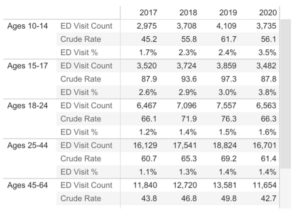Mental health-related outcomes are a point of great concern, particularly in times as tumultuous as these. One report from the Kaiser Family Foundation, found adults reporting symptoms of anxiety disorder and/or depressive disorder increased from 11% in 2019 to 41% in 2021. The CDC reported that, over the course of 2020, approximately 20% of US adults received some form of mental health treatment.
While the influence of the COVID-19 pandemic on mental health shouldn’t be understated, disorders including anxiety, depression, and suicide have been trending upward in recent years. Further, among youth age 10 to 24, suicide was the second leading cause of death, accounting for 6488 fatalities in 2019 alone. In this edition of Stories from the dashboard we aim to investigate a related mental health presentation, suicidal ideation, among youth presenting to emergency departments (EDs) using NC DETECT’s Mental Health Dashboard.
Suicidal ideation is typically defined as an individual having thoughts of wanting to harm themselves. Within NC DETECT, ED visits are flagged as related to suicidal ideation if they contain ICD-10-CM code R45.851. Due to the large decrease in ED visits following the COVID-19 pandemic, counts, rates, and proportions of visits are presented to facilitate multiple comparisons across years. In 2020, the statewide rate of suicidal ideation-related ED visits in North Carolina was 42.47 visits per 10,000 person-years, accounting for 1.1% of all visits.
Statewide trends of suicidal ideation-related ED visits, stratified by age category. Table (left) taken from the NC DETECT Mental Health Dashboard, plot (right) constructed using Dashboard data.
When stratified by age, children and young adults have higher rates of suicidal ideation-related ED visits than other age groups. North Carolinians aged 15 to 17 years had the highest rate of these visits in 2020, at 87.8 per 10,000 person-years, while those age 10 to 14 have comparable rates to 18-to-24 and 25-to-44-year-olds, at approximately 60 visits per 10,000 person-years. Additionally, county-level and zip code-level statistics can be found within the Dashboard.
These results, when contextualized with recent research, highlight the need for better attention surrounding youth mental health. In an article published in the Journal of the American Medical Association, authors found that the prevalence of suicidal ideation among high school students has increased each year since 2009. Further, the US Department of Health and Human Service’s Healthy People 2030 goal to lower the prevalence of suicide attempts among adolescents from 8.9% to 1.4%, is labeled as “getting worse,” with prevalence estimates rising since the goal was established in 2020.
That said, here in North Carolina, many officials are taking steps to prioritize the mental health of our youth. Several school districts across the state have approved more wellness days for both students and staff, while the University of North Carolina at Chapel Hill is convening a mental health summit in response to student and faculty concerns. Recognizing the importance of this health issue and initiating prevention efforts are important steps in safeguarding the mental health of North Carolinians.
If you find this topic interesting, and want to learn more, we recommend trying the dashboard for yourself!
NC DETECT authorized users interested in further investigation of these trends can also do so within the web application.


